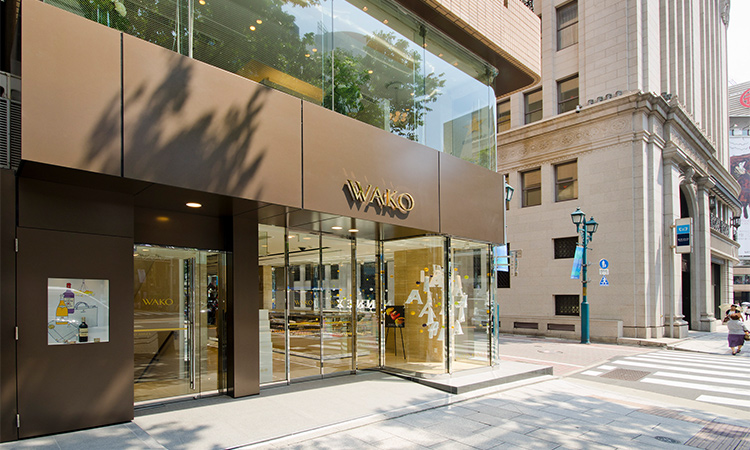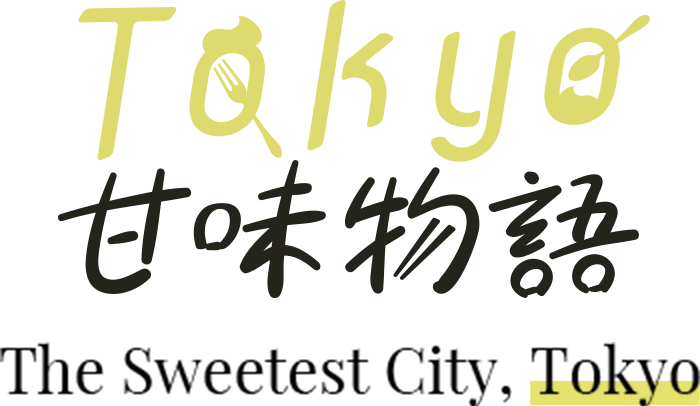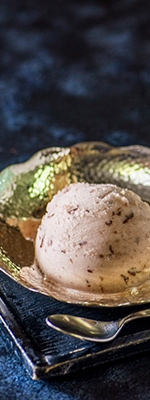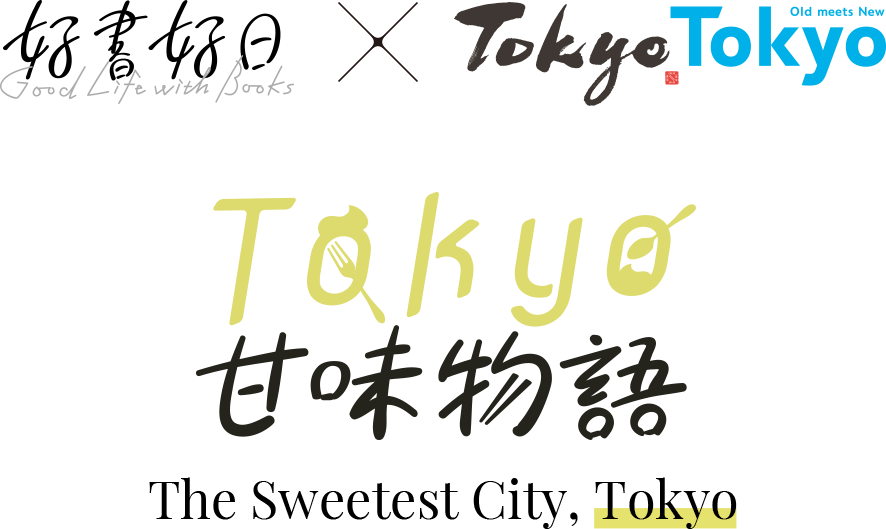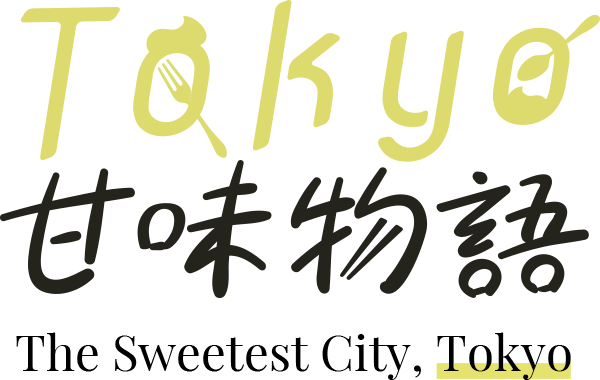
by the Prestigious Ginza-district Store WAKO
for Tokyo Tokyo
by the Prestigious
Ginza-district Store WAKO
"The Sweetest City, Tokyo" serial project explores the various confections of Tokyo, covering everything from famous selections of past eras whose traditions have been preserved to this day, through to new varieties based on constant innovation that never forgets historical roots. As a grand conclusion to this sweeping project, we secured the full cooperation of the historic and prestigious Ginza-district store WAKO to create unique confections just for Tokyo Tokyo, to be sold at their shop. The following is a look at what we and the WAKO professionals came up with. Part I of this special feature covers everything from prototype-product tastings through to final product completion.
[Reporting and Layout: Kanako Nezu]
Founded in 1881 as watch and jewelry retailer K. Hattori, the store was rebranded as WAKO in 1952, the year it began larger-scale sales operations. Its clock-tower-topped building, an iconic landmark of the Ginza 4-chome district, was build in 1932, and the adjacent building's WAKO Annex, occupying one basement level and two aboveground levels, became a provider of high-quality culinary selections. The first floor offers a lineup of 20 different sweets selections daily, including cakes, chocolate and more, while the second-floor tea salon is a popular place among Ginza visitors to enjoy those sweets.
[Official site] https://www.wako.co.jp/
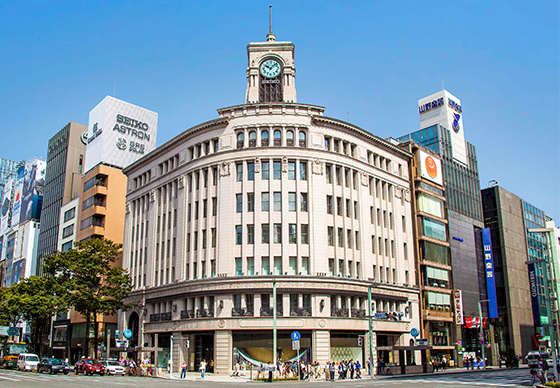
It is a cold winter day. A group of people has gathered together to discuss the original sweets products to be developed for Tokyo Tokyo. Those in attendance include two WAKO pastry chefs responsible for development and creation of the new menu items, Ryohei Oguma and Takahiro Matsume, as well as members of WAKO's Food Department and other company employees, representatives from the Tokyo Convention & Visitors Bureau, and our Good Life With Books team members.
In order to answer the simple question of what sweet truly represents Tokyo, we explored ways of expressing our "Old meets New" concept in confection form, with participants sharing their various ideas and opinions. Ultimately, we decided that the first logical step was to have the two WAKO chefs come up with ideas, and a few weeks later we held our first round of tasting sessions, which proceeded as follows.
WAKO Pâtissier Takahiro Matsume, who has 15 years of experience in his profession, prepared the baked confections. He provided three different types of pound cakes made using kinako roasted soybean flour and amanatto sugared beans.
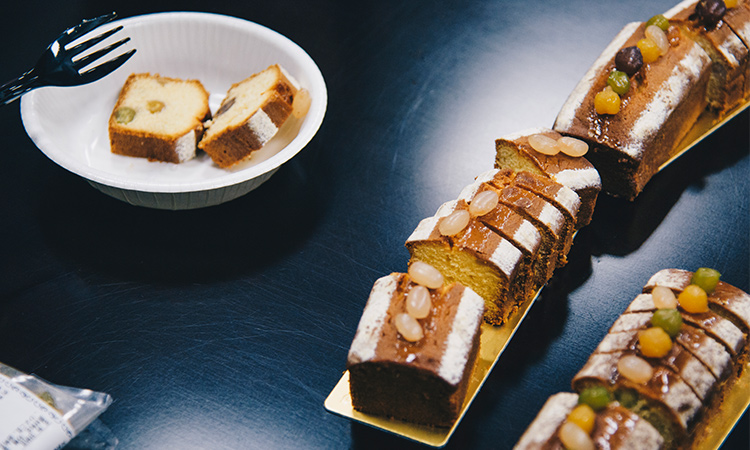
Kinako has been popular among the masses since the Edo Period (1600–1868), when confectioners were thriving in Japan. Mastume, explaining his choice to use this ingredient in the cake batter, explained, "I've used Japanese-style ingredients in a number of Western-style confections here at WAKO, and when trying to come up with an original ingredient for this project, kinako is what came to mind."
Akiko Yoshimaru and Ayame Ishii, who are in charge of WAKO original sweets development and marketing, led the tasting sessions. They played the important roles of "taste examiners," not only making sure the chefs' creations tasted good, but critiquing their works to help achieve products in line with what customers really want.
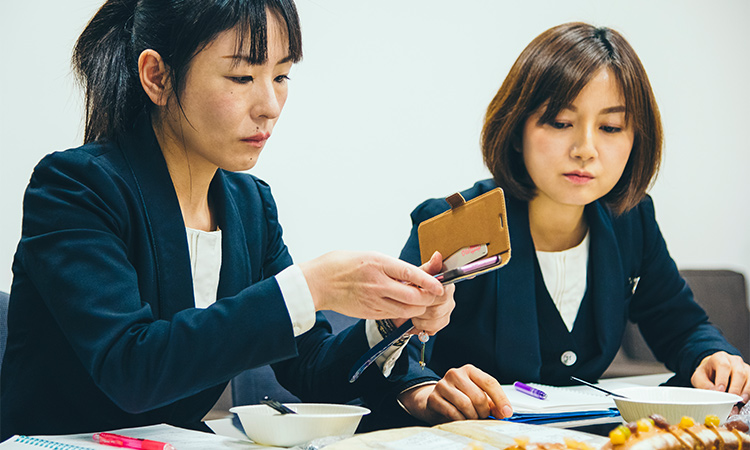
Visually examining and tasting each baked confection with serious expressions on their faces, they checked the cut cakes' cross-sectional appearances, inquired about quantities of kinako used in the batter, and showered the chef with a wide range of questions. In the end, both examiners agreed that there was not enough kinako flavor in the prototype products, in response to which Matsume explained, "If I use large amounts of kinako to bring out that flavor more, it's difficult to avoid a dried-out, crumbly cake texture." However, he refused to admit defeat. "I'll try making some minor adjustments to ingredient ratios and baking conditions to make something better without sacrificing the pound cake's moist texture."
For the creamy cake tasting session, WAKO pastry chef Ryohei Oguma was in charge of cake preparations. A participant on the Japanese national team at Coupe du Monde de la Pâtisserie 2019, the most prestigious of pâtissier competitions, Oguma helped his nation take home the silver medal (second place). For the Tokyo Tokyo project, he came up some ideas for a "shortcake of the future." The appearance of his proposed sweets featured vivid pink coloring that readily caught the eye, prompting exclamations of amazement from all present.
The ingredient responsible was ruby chocolate, which is considered the "fourth" variety of chocolate after milk, dark and white chocolate and has rapidly gained popularity in recent years. The bright pink color is naturally occurring in the cacao used for ruby chocolate, and Oguma used this same ingredient in the cream as well.
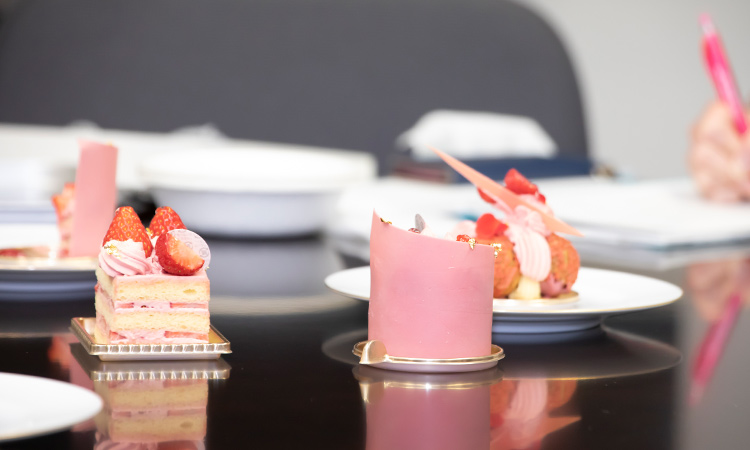
Both Ishii and Yoshimaru commented that the cream is very sweet, so perhaps a better balance between the sponge cake and cream was needed, or else the addition of more tartness. Responded Oguma, "The ruby chocolate itself has a bit of inherent tartness, but when used in cakes the sweet taste tends to stand out more. I'll try using other ingredients to find a better balance between tartness and sweetness."
Ultimately, Oguma provided three different types of cake, including a square variety and even St. Honoré cake—a traditional French confection made with choux pastry batter. All three of these creations tasted and looked great in their own ways, making it hard to choose a favorite among them. Selecting just one of the proposed confections for use as the final product was looking to be a difficult task indeed.
After Repeated Revisions
Following the tasting sessions, both chefs undertook repeated revisions based on the critiques received until they completed their final product proposals. Afterward, we sat down to talk to them about the completed confections.
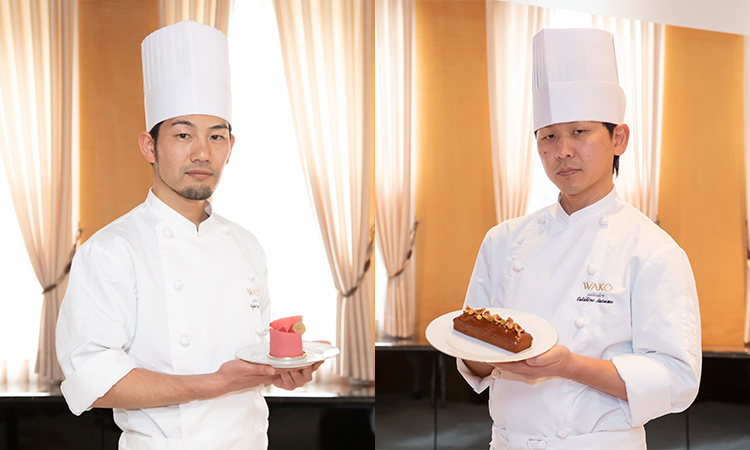
Right: Pastry chef Takahiro Matsume with his Cake Kinako.
Created by Ryohei Oguma (Creamy Cakes Category)
——Why did you choose a shortcake style for this original confection project?
When I learned that Tokyo Tokyo's "Old meets New" concept was the central theme for this project, I decided to focus on the local shortcakes of Tokyo created about a century ago as the "old," while using the currently popular ruby chocolate as the "new" to create a sort of "shortcake of the future." My goal was to use a novel ingredient to create an entirely new type of shortcake, both in terms of appearance and taste.
——Correct me if I'm wrong, but I'm guessing that your experience as a chocolatier is what inspired you to focus on ruby chocolate. What do you find so appealing about ruby chocolate?
The first thing that comes to mind is the color— the vivid pink is visually quite attractive. Unfortunately, it starts to take on a grayish tinge as time passes, and because ruby chocolate has very high viscosity it doesn't mold or flow well, making it hard to work with. Its flavor is similar to white chocolate, but with a bit of tartness added in. At WAKO, we used to sell a Christmas cake product consisting of vanilla and raspberry mousse coated with ruby chocolate, but this is the first time I have used ruby chocolate with a creamy-type cake.
——What improvements did you make between the initial prototype product and the final product?
By molding the ruby chocolate around the outside in a tubular fashion, I was able to add a variety of toppings, including raspberries and blueberries as well as ingredients like puffed rice and chocolate-covered raspberries for more interesting texture variation. On the inside, I added raspberries to the ruby chocolate cream between the cake sections in order to impart more tart flavor. I also sandwiched raspberries between the sponge cake and cream layers.
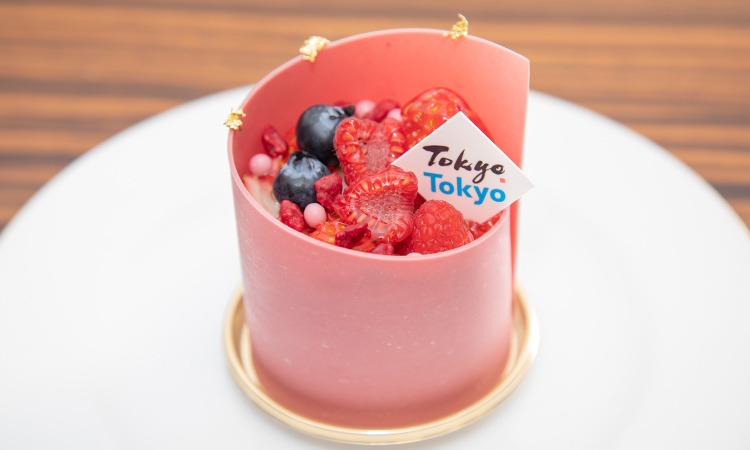
Created by Takahiro Matsume (Baked Confections Category)
——Tell me honestly, how did you feel when you received the offer to design an original confection product for Tokyo Tokyo?
Well, I had a difficult time choosing the right ingredients, but my main focus was on using Japanese-style ingredients. I entered this profession because I really enjoy making sweets, and I excited to make some prototype products for this project.
——What improvements did you make following the initial tasting session?
To start with, I added dried figs, jewelry raisins, and also the red balls which are chocolate-covered cereal. I had never thought to use dried figs together with kinako roasted soybean flour, but the singular texture and sweetness of this ingredient brings out the savory taste of the cake even more. For the amanatto sugared beans, I chose white kidney beans, which are often used to make shiro-an white sweet bean paste in Japanese confections. The aromatic properties of kinako match the cake well, and the ingredients seem to blend together as one when eaten.
——During the tasting session, they were told there was not enough kinako flavor, and the challenge of avoiding a dried-out, crumbly cake texture was also discussed. What improvements did you end up making in this regard?
After trying out a wide range of different kinako varieties, I used a type of domestically produced kinako not often seen in stores— this was the one with the strongest fragrant properties when used in the cake. I also used about three to four times the amount of kinako used in the prototype cake while carefully calculating water volume in order to achieve a moist cake texture.
——What are some of Cake Kinako's selling points?
With the upcoming 2020 Olympics and Paralympics in Tokyo, we expect to have a lot of visitors to Ginza from other prefectures as well as other countries. I hope as many people as possible will try this new-style pound cake made using a traditional Japanese kinako whose roots go way back into the past. Cake Kinako does not contain any spirits, so it can be enjoyed by a wide range of customers ranging from children to senior citizens.

We took part in repeated tastings after the initial sessions, during which the two chefs received additional detailed suggestions and advice. According to WAKO Food Department's Yoshimaru, "I kept asking for 'more kinako flavor' with each successive Cake Kinako prototype, until at last a satisfactory product was achieved. As for Oguma's Ruby Shortcake, I told him that it needed additional elements to keep the consumption process exciting all the way through to the end, and he ultimately achieved a perfected final product. The chefs took great pains to find just the right ingredients and make the desserts look appealing as well. I can proudly recommend these products to customers as true WAKO creations."
Added Ishii with a smile, "As a shop based in the upscale Ginza 4-chome district, we always strive to bring joy to customers of all ages and nationalities. Through these two new products, I think we can convey a lot of good things to our customers."
Matsume's Cake Kinako is made with familiar kinako and bean ingredients which have been loved by Japanese people for centuries, integrated into the popular Western-style pound cake format, whereas Oguma's forward-looking Ruby Shortcake focuses on the future of Tokyo shortcake style. Both represent the chefs' interpretations of Tokyo Tokyo's "Old meets New" concept and give expression to those interpretations in confection form. In part II of our special feature, we will take a closer look inside these sweets and explore their flavors in greater depth.
(Part II will be released in mid-March.)
In addition to Cake Kinako and Ruby Shortcake, the new product "St-Honoré Ruby" (¥750 before tax) was debuted on Saturday, February 15 at WAKO Annex's first-floor Cake and Chocolate Shop. This innovative take on the St. Honoré cake, a traditional French confection made with choux pastry batter, features the same cream as that used in the Ruby Shortcake. These new sweets are sure to become big hits in Tokyo, so come down to WAKO Annex and try them for yourself!
Cake and Chocolate Shop
[Location] WAKO Annex 1st floor, 4-4-8 Ginza, Chuo-ku, Tokyo
[TEL] 03-5250-3102
[Business hours/fixed holidays]
10:30 a.m.–7:30 p.m. (closes at 7:00 p.m. on Sun. and holidays), open year round
[Official site]
https://www.wako.co.jp/store_information/main/annex/index.html
